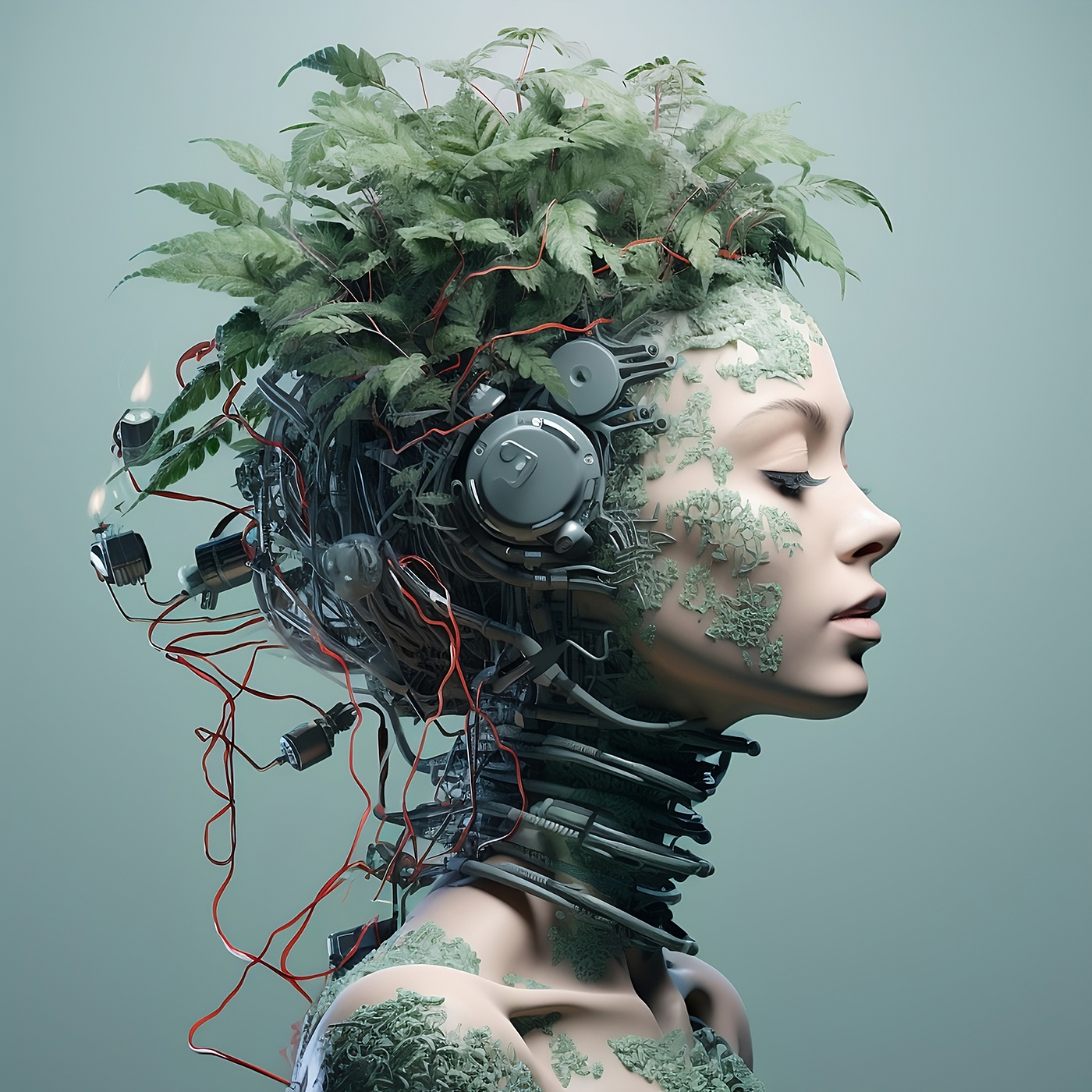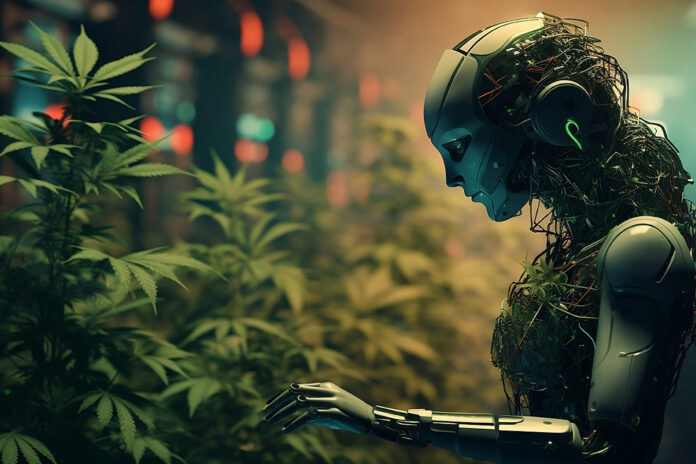In September of last year, Jason Reposa was given access to the beta of Stable Diffusion, a now-prominent image generator powered by artificial intelligence (AI). Using his son’s gaming PC with a powerful graphics-processing unit, Reposa started feeding prompts into the generator. The founder of Massachusetts beverage brand Good Feels began studying AI in college in the late 1990s as a computer science major, and he had maintained an active interest and foothold in the community over the years. But when Stable Diffusion started spitting out impressive images based on his commands, Reposa was stunned by the nascent technology’s latest leap forward.
“I had a full-on panic attack once I realized the impact,” he said. “I had a whole day where I just couldn’t function. The world literally just changed, and I was one of the very few people at that time who could see it. It was like walking around in the Matrix.”
Fast-forward just nine months, and many of us now see what Reposa saw. The results have excited and alarmed the population in roughly equal measure.
The catalyst for this explosion in awareness was ChatGPT, an advanced chatbot built by OpenAI that surged into the public consciousness last December. Curiosity about the novel tool that could create reams of coherent text from the simplest of prompts propelled it to one million users in just five days.
Since OpenAI-based software has become widely available, we’ve seen AI-generated viral images of the Pope wearing a white Balenciaga puffer jacket and Donald Trump wearing an orange jumpsuit, a fake Drake song so convincing it sparked debates about the end of the artist, and a deepfake of the Pentagon on fire that temporarily rocked the stock market. There has been widespread speculation that entire job categories—writers, software engineers, even architects—will be wiped out, while others have painted a vision of a productivity utopia where man is liberated from tedium by his machine assistant.
A pair of alarmist open letters signed by the likes of Elon Musk, Steve Wozniak, and Yuval Noah Harari begged for a pause on the development of AI tools until some regulation can be established. Meanwhile, OpenAI Chief Executive Officer Sam Altman has been on a highly publicized world tour of governments to preemptively request regulation, a move some have called noble and others have called cynical.
While individuals and governments fervently debate AI’s pros and cons, American business has been resoundingly bullish.
Microsoft and Google corporate parent Alphabet are engaged in a very public AI arms race to power the next generation of search, and the trickle-down hysteria is frothing the stock market. Seemingly any company perceived, rightly or wrongly, to be at the forefront of the artificial future is seeing a boost in its share price.
Chief among these companies is Nvidia, a graphics-processing company that briefly managed to rocket into the trillion-dollar-market-cap club on the back of the intense demand for its chips, which right now are the frontrunners for powering AI’s considerable computational needs. News that Nvidia would increase chip production added $300 billion in market capitalization to companies related to artificial intelligence in a single day.
The stunning pace of adoption and the rate of transformation are unlike any technological advancement in memory; perhaps even in history.
“I spend a lot of time looking at this stuff and monitoring the developments in the space, and I can’t even keep up,” said Jeremy Somers, creative director and founder of Not Content, an AI-driven content agency.
As an industry accustomed to the thrilling G-force of white-hot hype and the unpredictable mercy of government regulators, cannabis has wasted no time in seeking ways to integrate AI. Tools are being deployed throughout the supply chain in several exciting ways that could come at the perfect moment. With pressure to reduce costs, expand margins, and differentiate to attract scarce equity capital, cannabis businesses of all kinds are experimenting with the technology, hoping to to harness its seemingly limitless potential while avoiding the sharks that often swim in the big first wave.

Science from myth
Throughout history, the concept of artificial intelligence has captured the human imagination across cultures, dating back at least as far as the ancient Greeks. While the term “artificial intelligence” hadn’t been coined yet, intelligent machines appeared in myths like that of Talos, a giant bronze automaton created by Hephaestus, the god of fire and metalworking. Given to King Minos to protect the island of Crete from invaders, Talos’s job was to hurl boulders at enemies’ ships.
It wasn’t until the 1950s that AI transcended myth to become theory. A group of researchers, including the famous theoretical computer scientist Alan Turing, began exploring the idea of creating machines that could imitate human intelligence. The Turing Test was established as a means of assessing a machine’s ability to simulate human-like conversation. It involves a human judge who engages in natural-language, text-based conversations with two entities—a human and a machine—and tries to determine which is which. To this day, the Turing Test remains a widely referenced benchmark for evaluating the progress of artificial-intelligence research. By some accounts, ChatGPT-4 passed the Turing Test.
Fast-forward to the 1990s, when a technique called deep learning emerged. In essence, deep learning is like building a computer brain with multiple layers, with each layer learning to recognize different aspects of a problem. This technique revolutionized machine learning (ML) and paved the way for the significant advancements we see today.
But it should be noted much of what we call AI is more accurately described as machine learning, meaning algorithms trained on large data sets to perform complex tasks. ChatGPT is what is known as a large language model (LLM), so called because of the enormity of its data set (estimated at around one trillion words) and its function of simply predicting the most appropriate word to come next in a sequence.
AI as it was dreamed up in mythology and science fiction—sentient machines thinking and reasoning for themselves—is referred to as “artificial general intelligence.” Predictably, experts are divided on when—or if—humankind will achieve this breakthrough. Some say the seminal event will occur in a handful of years; others believe it will take decades. But with each new development, doubt that sentient machines are possible dwindles.
“AI is a bit of a misnomer, because it’s not true AI yet,” said data scientist and consultant Harry Peppitt. “It’s very smart, but it doesn’t think for itself. It’s not sentient, and if humans just stopped prompting it, nothing would happen.”
Peppitt has worked with machine learning tools for more than eight years, and his data-analytics startup 1Feed has integrated OpenAI’s generative pre-trained transformers (the GPT in ChatGPT) model to translate data into actionable insights for small businesses. He sees ML and LLMs as powerful tools in the hands of humans, not the source of our eventual extinction. “Much of the hysteria around AI comes from people not fully understanding what it is and what it isn’t,” he said.
Many of us might be able to recall the first time we interacted directly with generative AI tools like ChatGPT, Midjourney, or DALL-E, but we’ve actually been using tools like these for longer than many of us realize. When you write a text or email, the functionality that predicts the next word is essentially the same as ChatGPT. Alexa and Siri use deep-neural-network technology to convert vocal sounds into a probability distribution. Recommendation engines on Netflix and Amazon are trained on your data and the data of millions of viewers like you. These are all examples of advanced machine learning.
While the public enthusiasm for LLMs, ML, and AI arose swiftly, the tools have been removing friction from our lives quietly for several years. Now, the power to create and integrate them has been placed in our hands, and it’s transforming business in a major way.
Changing the industry
Every node in the cannabis supply chain harbors opportunities for improving efficiency, automating tasks, or leveraging advanced, previously unseen insights. AI, ML, and LLMs already are utilized by some of the cannabis industry’s more forward-thinking companies and executives, and many more companies are emerging and adapting with the technology at their core.
“Industries like AI and cannabis are super buzzy, and people want to be in them because the potential is enormous,” said Jesse Channon, chief growth officer at Columbia Care, a multistate operator actively experimenting with AI and ML in its processes and products. “But it’s easy to be intimidated when you start to grapple with the pace of change. People should just jump in and play with these tools, because you don’t want to swim against this tide.”
Ecommerce and customer service
The area that arguably stands to gain the most from AI integration on the shortest timeline is ecommerce.
Objectively, the design of dispensary menus from every major provider does not reflect the customer journey in the stores. Dispensaries are organized like supermarkets, which have aisles of familiar products that customers browse unaided. Because they’re relatively new, cannabis products can be confusing, which is why dispensaries use budtenders to guide customers. A bot that mimics the experience of a budtender in the ecommerce space is sorely needed, and a handful of enterprising young startups hope to solve the problem.
StrainBrain is one. A sophisticated AI budtender, the bot integrates with dispensary websites and guides customers toward the right product for them. By integrating with the menu provider, StrainBrain matches consumers with products using a complex vector-matching engine that encodes items on a scale using terpene data, direct brand communication, and aggregated experiential data.
“The core problem we’re solving is the paradox of choice in a confusing retail category. The more options there are, the harder decisions become,” explained founder and CEO Andew Leber. “StrainBrain helps customers go from scrolling through dozens of unfamiliar products to getting quick, personalized recommendations based on what they want.”
Leber and co-founder Graham Bohm have impressive backgrounds. Leber studied computational biology and founded the largest student-run AI organization in the world, which was sponsored by Microsoft and IBM. He recently turned down the chance to seek a PhD in artificial intelligence at Oxford University in order to start StrainBrain, while Bohm forewent a position at prestigious management consultancy McKinsey.
“Fundamentally, we’re a tech company working in cannabis, whereas most other cannabis-tech companies I’ve encountered are cannabis companies working with technology,” said Leber.
Early data from StrainBrain suggests the tool is resoundingly successful. More than 150 stores use the software, and customers spend an average of 23 percent more after interacting with it. The company is about to release a novel subscription-based ad solution for brands, and the beta tests suggest this will solve another ecommerce problem: low returns on digital ad spend.
“Our ads have taken a brand from being the sixth-best-selling vape in a store to the second-best-selling in two weeks without discounting,” said Leber. “The stores love it, the brands love it, and the customers get products they want.”
Chatbot Pluggi’s latest feature is an integration that enables it to answer store-specific questions (hours of operation, whether the store accepts credit cards, etc.), making it akin to a “super staff member.” “We’re training it specifically on our partners’ websites so it can answer frequently asked questions relating to things like payment processes and current deals running,” said Wyatt Hahn, Pluggi’s founder.
Given the reasonable cost of the plug-ins (StrainBrain is $150 per month, though the company also offers a free version) and the lift in revenue they can generate, dispensaries would be well-advised to investigate consumer-facing AI to help customers navigate menus that typically are built for the ways people shop virtually, not the way they actually buy cannabis.
Content creation
With ChatGPT, Midjourney, and DALL-E being the first AI tools widely available to the general public, it was clear content creation would be one of the first areas poised for disruption.
Not Content’s Somers remembers being blown away by a now-famous avocado-shaped chair created by DALL-E in 2021. “In just this one picture, I understood immediately what this meant for all creative industries,” he said. “I became really obsessed with AI. I got access to these tools as soon as I could and just dove right in.”
He spent hours and hours refining his prompts, generating images, and feeding them back into the generator before he obtained results he deemed strong enough to commercialize. Now his agency creates content for clients like non-alcoholic beverage brand Kin much faster and more affordably than was possible with purely human labor in the past. “I’m consistently shocked at how much the content is improving, how much we are creating, and how low the cost is,” he said.
“These tools are really streamlining how people build marketing campaigns,” said Tyler Wakstein, co-founder of cannabis event series Trailblazers and an active industry investor. “If a cannabis company is not making their marketing department more efficient, they’re going to be left behind.”
Wakstein has been using chat engines to come up with ideas for Trailblazers and first drafts of copy for its website. “It’s an exciting time,” he said. “My background is in marketing, branding, and storytelling, and these tools are turning ideas into execution and action items super quickly and at a high level.”
Another area of content creation on the verge of an overhaul is search engine optimization (SEO). Fear swept through the content-marketing profession like a January gale when it became clear Google and Bing (owned by Microsoft) had a distinct vision for the future of search: delivering users a page with an aggregated, in-depth answer to their query as opposed to a list of ranked websites they could visit.
For a moment, it looked like the future of search engine optimization as a profession could be in jeopardy. But Jeremy Johnson, an SEO expert and business-development manager at menu provider Dispense, sees this as just another shift in what it means to optimize for search. In fact, impending changes could benefit dispensaries.
“There are going to be some instances where people lose traffic because Google is just displaying an answer instead of giving you the click-through to the website,” Johnson said. “But it won’t decrease ecommerce traffic, because you’ll still have to click through to the website to make a purchase.”
He added Google is starting to prioritize local retail over national or global ecommerce platforms for certain products and services. With cannabis retail being entirely local, at least for the time being, this is expected to help stores.
But if dispensaries want to keep receiving organic search traffic in this new era, Johnson believes they need to move away from the iFrame menus offered by many third-party providers, because Google can’t read those.
Johnson isn’t concerned about AI disrupting SEO. He believes the rules of the game will remain the same. “If you’ve been doing SEO right and you’ve been writing valuable content this whole time, your content is just going to get boosted that much more, particularly as more generic AI-generated content floods the internet,” he said.
Cultivation and product development
AI also presents tremendous opportunities in agriculture. Growers can utilize modern tools for tasks like accurate image processing, data analysis, forecasting the cost of cultivation, infertility prevention, crop management, water-use recommendations, and labor reduction.
AI Grow, founded in 2019 by a group of veteran software engineers who recognized growers could benefit tremendously from industrial automation, aims to bring AI to cultivators. “Our solutions help cultivators of all sizes operate more efficiently, reduce their resource use, and increase yields,” said Kurt Kinneman, AI Grow’s horticulture engineer. “With cannabis margins being razor-thin, the technology we deploy is a huge cost-savings for our clients and can make a world of difference.”
The company’s software uses automation to help growers be more efficient with everyday tasks by setting custom parameters and controlling analog or digital devices to maintain watering, lights, fertigation, and environmental monitoring. Data is harvested throughout the life cycle of the plant and utilized to ensure each strain has precisely what it needs to maximize yield.
One of AI Grow’s biggest undertakings thus far was a 25,000-square-foot mixed-light greenhouse in rural Wisconsin. The installation facilitates increased output, reduced energy costs, and maximum yields regardless of environmental conditions. “Whether it’s twenty below zero and bone dry or 100 degrees with 80-percent humidity, their plants are always the best they can be,” Kinneman said.
When it comes to product creation, major food companies like Mondelez International have started exploring AI’s potential for new product development. Opinions, however, are divided about how impactful current AI technology can be in this pursuit.
Carolina Vazquez Mitchell is a scientist and product developer working in both the cannabis and food industries. She has developed more than 200 cannabis products, including some for her own company, Ciencia Labs, as well as products for Pepsi, Taco Bell, and Quaker. She has been tinkering with AI, and while she has found the technology helpful for the administrative components of her day-to-day business, its limitations cannot be ignored.
“When I’ve asked AI tools to create recipes for me, they have made very basic scientific mistakes, like suggesting I make emulsions out of only oil and water,” said Mitchell. “Can it give you ideas for flavors? Sure, but it cannot be trusted to give you something you can actually use, particularly not at scale.”
Labor Relations
The biggest near-term concern about AI is its potential threat to jobs. When Dr. Geoffrey Hinton, Google’s head of AI development and the so-called godfather of AI, quit the company in May to speak publicly about the dangers of the technology, he cited widespread unemployment as the first horseman of the AI apocalypse. A recent survey from New Qualtrics found although 64 percent of executives called AI “exciting,” only 39 percent of employees felt the same way. In fact, 46 percent found it “scary.”
Data scientist Peppitt is firmly in the excited camp. He believes the hysteria about mass job loss emanating from the AI “doomers” is overblown. “What I keep telling people who ask me if this is going to take their jobs is that this is a tool,” he said. “The technology might change how people work, but it won’t put people out of jobs en masse because it isn’t operating independently on its own. You still need human operators.”
Fears about technology killing jobs historically have been overblown. Research by economist James Bessen indicated only one of the 270 occupations listed in the U.S. census in 1950 has been automated out of existence: elevator operator.
“When business-intelligence tools like Tableau were introduced, we didn’t get fewer analysts. We got more analysts, and business performance improved,” said Columbia Care’s Channon. “I don’t see why AI won’t be like that. I think you’re about to see the emergence of an entirely new class of creators.”
What should we do?
Firstly, if all of this is new to you, don’t panic. Regardless of what you do, you’re probably not going to be replaced by an AI bot anytime soon. While AI arguably is the fastest-moving technological revolution in living memory, there’s still plenty of time for you to start learning about the technology.
“It feels like there’s this mad rush happening and if you’re not using all these tools you’ll get left behind, but that’s not really the case,” said Somers. “It’s just a subset of people who are being really loud on LinkedIn about this.”
Unless your job is hand-trimming flower or unloading distribution trucks, there’s probably some way you can incorporate AI into your role to improve productivity. If you operate a store, recruit an AI budtender. The digital assistant will increase revenue and improve the customer experience. If you are a marketing professional, start playing around with AI tools to create content and generate ideas. Growers should investigate every technology that could help increase margins and guarantee higher yields.
But don’t go haywire and fire your staff because you have a ChatGPT-4 subscription. As smart as these tools are, they’re still in their infancy and prone to a litany of errors, including so-called hallucinations that cause the machines to lie. At least right now, the tools are only as smart as the humans developing, using, and fact-checking them.
The one thing you absolutely shouldn’t do is bury your head in the sand and pretend the AI revolution isn’t happening. You could be forgiven for not creating a redundant app for your company in 2013, getting “on the blockchain” in 2017, or dropping a non-fungible token in 2022. But AI is different. Its applications are widespread, its impacts are tangible, and getting started is relatively inexpensive and easy … today. As the technology matures, that likely will change.
“This is like a boulder coming down a hill,” said Good Feels’ Reposa. “You need to have a plan for how you don’t get crushed underneath it.”














[…] helping reduce crop loss and improve efficiency, particularly in cannabis cultivation, where artificial intelligence (AI) holds immense value. AI-assisted forecasting is a critical tool for cultivation facilities, […]
[…] seed to sale and even in consumers’ hands, software and hardware—alone and in combination with artificial intelligence (AI), automation, computer vision, and machine learning (ML)—are transforming the value chain, […]
[…] the march of technology meets the nuances of human expertise. Right now, we’re witnessing an unprecedented integration of artificial intelligence (AI) into personalized consumption, and this shift is transforming the retail […]
[…] said Andrew Leber, founder and chief executive officer at StrainBrain, which has developed an artificially intelligent virtual budtender. “We had a lot of face time with potential investors, partners and retailers, […]
[…] Professionals in the manufacturing and processing sectors have witnessed firsthand the profound influence of artificial intelligence (AI), automation, computer vision, and machine learning (ML). It’s time we explore the space race […]
[…] to improve our personal and professional lives in ways we probably haven’t even conceived. In his artificial intelligence feature in mg Magazine’s August 2023 issue, Robert Mira reveals some of the ways highly trained systems […]
[…] intelligence (AI) is beginning to feel like the next seismic technological shift, steadily pouring into every facet of modern life from art to business, education, politics, and […]
[…] like cannabis is enormous, attracting companies looking to integrate the technology at their core. Source link Source link: […]